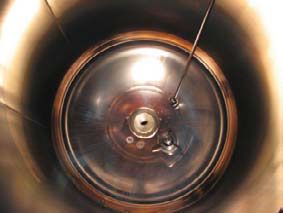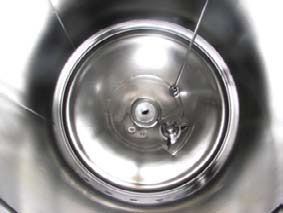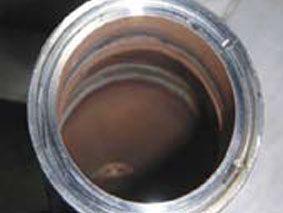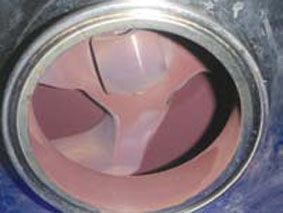DEROUGING AND PASSIVATION OF STAINLESS STEEL INSTALLATIONS
In practice, it is not unusual for rouging to affect stainless steel surfaces. The stainless steel pipe systems that are mainly used in the pharmaceutical and biotech industries do not escape rouge either. On PW or WFI systems, layers of reddish coating are visible in most cases, while on pure steam (also referred to as "clean steam") systems, the coating that disrupts the system appears as a rough black layer that is firmly attached to the inside of the pipe. These situations often produce rouge particles, some of which can be carried over by the flow of product into other areas of the pipework where they may be deposited.
Especially in the "clean" pharmaceutical sector, all of this means that rouge is not a subject that can be taken lightly.
Removal of rouging: stay "on the ball" Passivation of new systems is an important factor in the prevention of rouging. Even so, it does not offer protection for ever. Various factors such as an insufficient percentage of oxygen combined with warm or hot operating conditions can cause rouge to form again over time. The only way to guarantee a safe solution is regular derouging and repassivation of the system.
Problems caused by rouging at a glance:
- particles of heavy metal oxides that can contaminate the medium
- microcorrosive attacks on the stainless steel surface
- germs are encouraged to breed on the stainless steel surface/a biofilm is formed.
Rouge - an unpleasant side effect
Many industrial pipe systems and containers are made of stainless steel. At the warm operating temperatures that are usual, pure media (WFI-water, pure steam) can cause surface corrosion on the used stainless steel. The typical product of this corrosion (reddish particles with a rich iron oxide content) after the appearance of the surface is called the rouging effect.
Chromium – helps to protect
The chromium contained in the stainless steel reacts with oxygen to form a protective layer with a rich chromium oxide content - the passive layer. The aim is therefore to strengthen this protective layer by additional passivation.
Some like it hot ...
... and the iron oxides are among them. The hotter the temperatures become in the system, the more they multiply. The protective passive layer is in a dynamic chemical equilibrium. Higher temperatures lead to increased formation of iron oxide at the cost of the chromium oxide component, and this disrupts the chemical equilibrium of the passive layer. Inadequate passivation, incorrect weld seams and/or low-quality material or surface execution are additional factors that can encourage the development of rouge.
Rouge must not be overlooked
In water systems, it generally takes the form of a red to reddish-brown coating which forms or settles on the inner sides of the pipes. Sometimes, though, rouge appears "all dressed in black" - as may happen in pure steam systems, for example. One thing is certain: stainless pipe systems and process systems are not safe from rouge– "stainless" does not mean protection against rouge.
The effects of rouge
Rouge is only slightly bonded to the metal surface, so it can detach and be carried along in the system in the form of particles. The results: on the one hand, deposits form in areas with low flow rates, leading to contamination of the system and its products. Especially in the pharmaceutical sector and in biotech production, the loss of the defined sterile conditions in the system is absolutely intolerable. Sustained success can only be ensured by regular cleaning, derouging and repassivation.
Passivation: Get off to a good start
Rouging is a latent risk - from the very outset. That's why every new system should be professionally passivated, to delay the development of rouge for as long as possible. However, a successful procedure calls for a great deal of know-how and experience - assets that our staff can always offer.
Regular maintenance for lasting success
If you don't keep at it, you get rusty - that's the motto with rouge. Even after successful passivation, the protective layer of chromium oxide can be eaten away after a certain time. The tiresome consequence: rouge can start to spread again.
So stay "on the ball" and have your system inspected and routinely maintained on a regular basis, at least once a year. Depending on the formation of the rouge, we recommend a derouging/repassivation process as part of a routine procedure defined by SOPs every 6 to 12 months. This will guarantee your system against serious formation of rouge as well as the latent damage and increased costs that can ensue. Risk analyses on this aspect can also be compiled.
Towards success - safely
At ATECO, safety is an important area where we are very active. Full documentation of our work, using precisely defined chemicals from safe sources, and last but not least our highly professional and experienced staff - these factors allow us to guarantee you a reliably successful operation on every application, without impairing your system.
Cleanness with no residues
After every cleaning procedure, ATECO guarantees you the safety of a system that is clean and free from residues. Our specialists use defined inspection parameters and suitable analytical techniques to ensure that the rouging layer as well as the residues of cleaning products are reliably removed.
Safe disposal
Chemical cleaning operations such as derouging and passivation generate quantities of waste water. Before this water is fed into public sewage systems, it must be properly neutralised and cleaned according to local statutory regulations. Using ATECO chemicals you avoid this troublesome issue, because all the processes are conducted at neutral pH.
Safety that can be proven
With ATECO, you receive protocols that give you the security of a validated procedure for all cleaning, derouging and (re)passivation operations. A specific safety concept is drawn up for each project, with precise instructions concerning safety at work, safety clothing and emergency action.
The newly-engineered pH-neutral derouging agent DIRUNEUTRA – for which a patent application has been filed – is the ideal alternative to the aggressive acid solutions which have been used in derouging operations up to this point. Its use is safer and more affordable overall – what's more, its disposal is easier and it fulfils the recently tightened requirements for installation (and environment) protection.
After the derouging process, the passivation takes place either with Dirupass AP (acid) or Dirupass NB (pH-neutral). These products were specifically engineered for validated cleaning/passivation.
The combination of Diruneutra and Dirupass AP or Diruneutra and Dirupass BN enables an individualised process which is best adapted to each user – and effective.
ATECO Product Overview:
| pH-neutral Derouging System | Diruneutra LIQ / P |
| Passivation acid | Dirupass AP |
| Passivation ph-neutral | Dirupass NB |
Passivation protects against rouging
As well as iron, stainless steel alloys also contain chromium, nitrogen, molybdenum and other components depending on the smelting product. Chromium in particular combines with oxygen to build up a stable layer that is rich in chromium oxide, protecting the system against rouge. This passive layer (as it is known) can be additionally reinforced by chemical passivation. To allow rouge as little opportunity as possible right from the outset, it follows that new systems should be professionally passivated as soon as they have been installed.
Clean – flush – passivate – flush ......
that's how the passivation procedure runs. The entire system is flushed through in a closed circuit. To do this, ATECO uses chemicals that will not attack the stainless steel pipes.
During passivation, a protective layer that is rich in chromium oxide is formed on the surface. The use of suitable chemicals also increases the ratio of chromium to iron on the surface. This is a good thing, because the higher the percentage of chromium on the surface, the more the passive layer will develop - which in turn reduces susceptibility to corrosion.
Regular cleaning and repassivation
High temperatures (during welding jobs, for example), scratches on the surface or just the passage of time will weaken the passive layer. The effect: rouge can start spreading again and a renewed cleaning operation or a derouging and repassivation process become necessary. The fact is, that lasting success in the fight against rouge is only possible if repassivation is carried out on the systems at regular intervals.
1. Derouging of stainless steel even without use of aggressive media
Press release , 2011
2. Passivation with Dirupass AP
ATECO Technical Report, 2010
3.PH-neutrale Reinigungsmittel reinigen Edelstahloberflächen zertifiziert und umweltschonend
Online-Artikel auf process.de
4.Sanftes Derouging von Edelstahl mit Diruneutra - PH-neutrale, umweltschonende Reinigung
PROCESS PharmaTEC, Ausgabe 3, 2008
5. Derouging - Now with ph-neutral cleaner
ATECO Technical Report, 2008
6.Wenn Edelstahl errötet
CITplus Magazin, Ausgabe 5, 2007
7.Derouging - Aktives Passivieren
a3-Volt Magazin, Ausgabe 5, 2007





